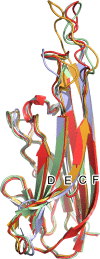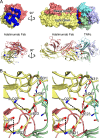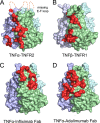Comparison of the inhibition mechanisms of adalimumab and infliximab in treating tumor necrosis factor α-associated diseases from a molecular view
- PMID: 23943614
- PMCID: PMC3779706
- DOI: 10.1074/jbc.M113.491530
Comparison of the inhibition mechanisms of adalimumab and infliximab in treating tumor necrosis factor α-associated diseases from a molecular view
Erratum in
- J Biol Chem. 2014 Aug 1;289(31):21296-7
Abstract
TNFα-targeting therapy with the use of the drugs Etanercept, Infliximab, and Adalimumab is used in the clinical treatment of various inflammatory and immune diseases. Although all of these reagents function to disrupt the interaction between TNFα and its receptors, clinical investigations showed the advantages of Adalimumab treatment compared with Etanercept and Infliximab. However, the underlying molecular mechanism of action of Adalimumab remains unclear. In our previous work, we presented structural data on how Infliximab binds with the E-F loop of TNFα and functions as a TNFα receptor-binding blocker. To further elucidate the variations between TNFα inhibitors, we solved the crystal structure of TNFα in complex with Adalimumab Fab. The structural observation and the mutagenesis analysis provided direct evidence for identifying the Adalimumab epitope on TNFα and revealed the mechanism of Adalimumab inhibition of TNFα by occupying the TNFα receptor-binding site. The larger antigen-antibody interface in TNFα Adalimumab also provided information at a molecular level for further understanding the clinical advantages of Adalimumab therapy compared with Infliximab.
Keywords: Adalimumab; Antibodies; Autoimmune Diseases; Crystal Structure; Epitope; Mechanism; Protein Targeting; Tumor Necrosis Factor (TNF).
Figures






References
-
- Shealy D. J., Visvanathan S. (2008) Anti-TNF antibodies. Lessons from the past, roadmap for the future. Handb. Exp. Pharmacol. 181, 101–129 - PubMed
-
- Palladino M. A., Bahjat F. R., Theodorakis E. A., Moldawer L. L. (2003) Anti-TNF-α therapies: the next generation. Nat. Rev. Drug Discov. 2, 736–746 - PubMed
-
- Aggarwal B. B. (2003) Signalling pathways of the TNF superfamily. A double-edged sword. Nat. Rev. Immunol. 3, 745–756 - PubMed
-
- Tansey M. G., Szymkowski D. E. (2009) The TNF superfamily in 2009. New pathways, new indications, and new drugs. Drug Discov. Today 14, 1082–1088 - PubMed
Publication types
MeSH terms
Substances
Associated data
- Actions
LinkOut - more resources
Full Text Sources
Other Literature Sources

